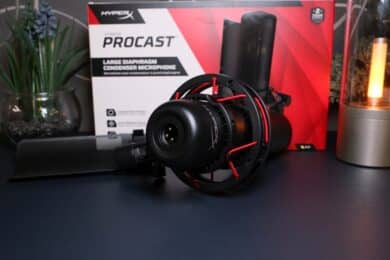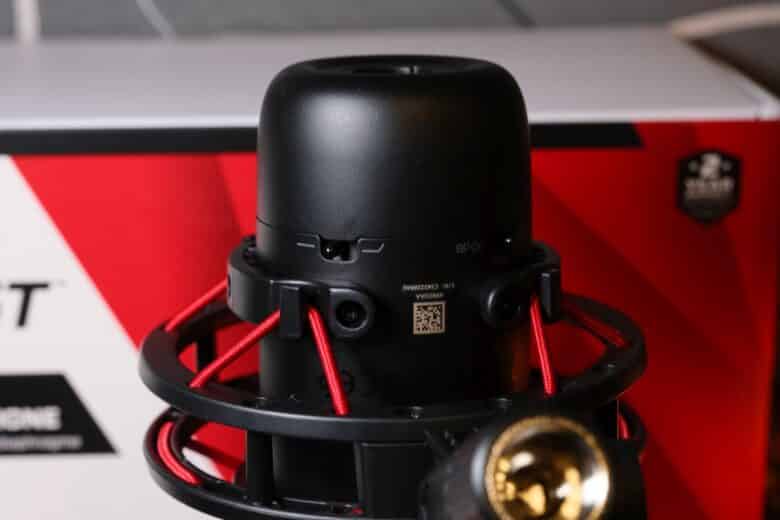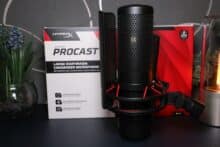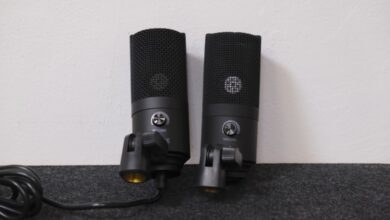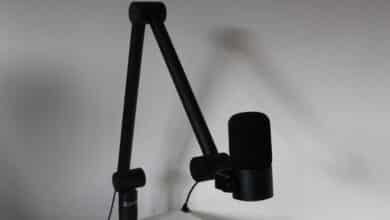
After Elgato has already launched an XLR professional microphone with the high-quality Wave DX, HyperX is now jumping on the bandwagon. With the ProCast, they want to offer a particularly high-quality XLR microphone with a cardioid pickup pattern, which is primarily aimed at streamers and content creators. Our HyperX ProCast review clarifies whether this has been successful.
Technical data
| Element | Gold-coated, externally polarized capacitor |
| Connection | XLR (3-pin) |
| Impedance | 160 Ohm |
| Sensitivity | -38 ± 3 dBV (1 V/Pa at 1 kHz) |
| Directivity | Cardioid |
| Frequency range | 20 Hz – 20,000 Hz |
| Dimensions (height x diameter) | 210 mm x 55 mm |
| Weight | 376 grams (microphone); 503 grams (microphone + pop filter + spider) |
| Price | € 197.99 * |
HyperX ProCast review: design and scope of delivery
- High-quality, rugged build
- Sleek, sleek design
- Overwhelming scope of delivery
After various USB microphones such as the Quadcast (our review) and the Quadcast S (our review), HyperX is now also launching an XLR microphone. In terms of design, the manufacturer stays true to its line and once again relies on dark black tones, a silver logo and red details.
As chic as the design turns out, the scope of delivery is all the more manageable. In addition to the microphone itself, a removable metal pop shield and a removable shock mount, also known as a microphone spider, are included. The whole thing is rounded off by a manual and the usual paperwork.
Accordingly, not included are a mount for table or similar or an XLR cable. Thus, the HyperX microphone has to endure the same criticism as Elgato did with the Wave DX. At least an XLR cable and a table mount would have been expected for the price. At least a high-quality microphone spider is included.
On the other hand, there is nothing to complain about the basic design and build quality. The HyperX ProCast is completely made of metal and weighs 376 grams without accessories. With the shock mount and pop filter, it is even over 500 grams, which speaks for robustness.
On the back, the microphone has a dual threaded connection for connecting to boom arm and microphone stand. The 3/8-inch and 5/8-inch threads offer a wide range of connectivity.
A 3-pin XLR cable connects at the bottom. Through the hexagonal openings in the upper third, the microphone’s gold-plated large-diaphragm condenser capsule can be spied. With a height of 209 mm and a diameter of 55 mm (without the spider), the ProCast is one of the larger microphones.
Unlike its Elgato counterpart, the HyperX microphone features two additional switches on the back, more on that in a moment.
Operation and practical test
- Two switches for fine-tuning the sound
- Audio interface with 48V phantom power is mandatory
- No stand included
Let’s first turn to the two switches on the microphone. The left one is for passive attenuation and offers the possibility to reduce the signal level by 10 dB. Handy if you want to record loud instruments, for example, as this prevents any distortion.
The right switch, on the other hand, has only two dashes. It is responsible for the 80 Hz high-pass filter. This reduces output levels at 80 Hz by three decibels, which should suppress low-frequency and muffled sounds in particular somewhat.
So far, so good. But in order to be able to use the HyperX ProCast at all, it still requires a number of accessories. For example, an XLR cable is mandatory, which you can get for a few euros. But you also need a suitable audio interface to be able to use the microphone.
And here you are, in the best case, with another 100 euros. A table mount or microphone arm is also needed. This is by no means unusual in the field of XLR microphones. But you should definitely consider it when purchasing.
Thus, the HyperX ProCast is definitely not a bargain. On the other hand, this puts the price of the Elgato DX back into perspective, because here you get the microphone and the required audio interface for the same price that HyperX only charges for the microphone.
A 48V phantom power supply as an external power source is also mandatory for the HyperX device. But most audio interfaces can handle that anyway.
Recording Quality of the HyperX ProCast
- Excellent dynamic voice recording
- High frequency response, convincing sensitivity
- Relatively susceptible to ambient noise
The comparatively high price is then reflected in the specifications of the HyperX ProCast. With a frequency response of 20 Hz. to 20,000 Hz, the XLR microphone reaches further into the bass range as well as the treble than the competitor from Elgato.
In addition, the impedance of 160 ohms is significantly lower than the 600 ohms of the Wave DX. However, this difference is only really relevant in professional recording studios that use long cables.
Both XLR microphones have the cardioid polar pattern in common, which is accordingly more suitable for solo recordings than for group podcasts or similar. However, the sheer size of the built-in diaphragm can be clearly seen through the metal jacket, which ensures high recording quality in practice and provides more room to maneuver when you’re not speaking (or singing) directly into the microphone head-on. The included clip-on metal pop shield also marks a good starter solution for softening plosives and sharp S sounds.
Sound-wise, the HyperX microphone’s recordings are quite impressive, with a high dynamic range, a clear presentation, and excellent volume and sensitivity, which also captures soft whispers skillfully and is therefore certainly quite suitable for ASMR recordings.
In direct comparison with Elgato, I find the HyperX ProCast’s sound characteristics to be a bit cooler, but a bit more detailed. However, the HyperX model proves more susceptible to background noise such as typing on the keyboard, traffic noise or fans. Here, however, the 80 Hz high-pass filter does a good job of hiding these, at least for the most part.
HyperX ProCast review: conclusion
The XLR microphone HyperX ProCast does quite a lot right in the test and scores especially with its robust construction, high-quality workmanship and its really convincing, dynamic sound. It is also practical and praiseworthy that the manufacturer includes a removable metal pop shield and that you can adjust the high-pass filter and passive attenuation directly on the microphone.
When it comes to pricing, it’s obvious that HyperX has taken its cue from popular podcasting models like the Shure SM7B or similar high-quality models, which you can largely keep up with very well from a sound perspective.
Nevertheless, the comparatively high price weighs quite heavily, while a microphone stand and an XLR cable would have been good for the microphone in the scope of delivery. The ProCast is primarily aimed at semi-professional or professional users and does its job very well in this area.
In combination with the accessories required for use, it is definitely anything but a bargain, but in direct comparison to a USB microphone, the sound quality is also much better. However, this does not mean that there are not cheaper solutions that reach a similarly high level.
For voice calls, game chats and most everyday applications, the ProCast is clearly overkill. Streamers or podcasters, however, will get a really very good sound quality, but it will only reach its full potential in relatively quiet environments.
HyperX ProCast
Workmanship
Recording quality
Features
Value for money
89/100
High-quality and robust XLR microphone, which is definitely in the (semi-)professional segment and can convince there sonically. However, the price is too high.





